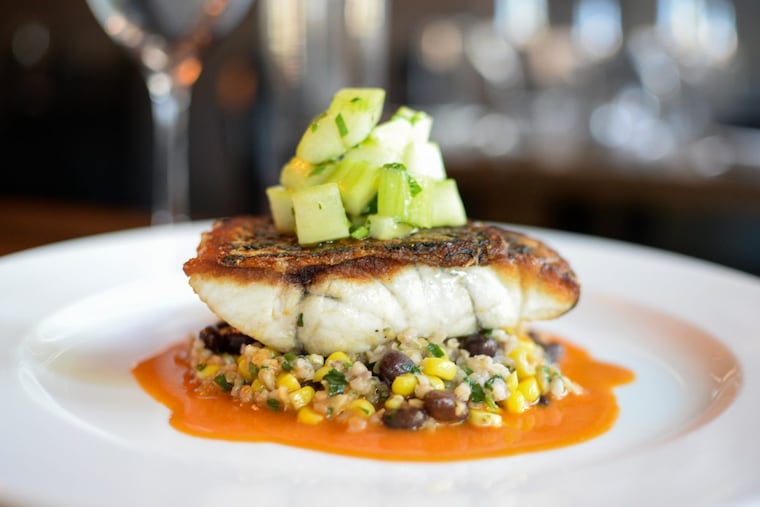Barramundi is starring on menus in Philly. Is it the next big fish?
Affordable, sustainable, healthy, and delicious - is there anything barramundi can't do?

Some fish have skin that crisps up when seared and holds together on a grill. Other types of fish flake perfectly when cooked, falling away in layers of delicately flavored meat. Some fish are healthy and nutritious; some are farm-raised. Some have a light, clean flavor that goes with anything.
In a sea full of fish, the humble barramundi is all of these things. Versatile, sustainable, and delicious, the fish also known as Asian sea bass checks just about every desired box for seafood purveyors, chefs, and diners. That's why it's appearing on more menus in the region and across the country, and why industry experts say it's poised to become the next big catch of the day.
"Chefs are always looking for something new and exciting, but it has to be consistently available and at a reasonable price point," said Joe Lasprogata, a vice president at Samuels & Son Seafood. "Part of the reason you're seeing this one advance so quickly is that it meets so many of these criteria … I take it home with me myself."
Indigenous to the South Pacific, primarily Australia, "barramundi" translated loosely from Aboriginal means "large-scaled river fish." But it can also be found in coastal waters, estuaries, and lagoons. The fish can live in fresh or salt water, and have a predilection toward an environment that mimics the conditions created by many fish farmers.
"Whereas sea bass and striped bass spawn in fresh water and live their adult lives in the open saltwater sea, barramundi … do the exact opposite," Paul Greenberg wrote in his 2010 best-selling book, Four Fish: The Future of the Last Wild Food. "Living this way means they migrate into fresh water in summer and often get stuck in billabongs, areas of river that get cut off and become stagnant during dry seasons. In an odd way, what billabongs resemble most are big, natural aquaculture tanks."
Devon Seafood Grill started serving barramundi about six years ago, said general manager Scott Siemianowski, as part of an effort to start seeking out more sustainable fish. The restaurant sources it from a farm in New Zealand that raises the fish in sea pens, large contained areas in the ocean.
"Before, it used to deter people when they heard a fish was farm-raised," he said. "In this case, they're actually swimming in the ocean."
Barramundi are typically harvested at 10 to 12 pounds, and under the right conditions, they can spawn throughout the year. They are disease-resistant and can live mostly on vegetarian feed, which makes them less prone to contamination. Additionally, Greenberg wrote, "barramundi can do something almost no other fish can do — they can make the omega-3 fatty acids from vegetarian oils."
Taken together, these attributes make barramundi sustainable, without the fuel and other costs associated with deep-sea fishing, and it's so regularly available that sellers can keep the price consistent across the seasons. When another type of fish isn't available, barramundi can swoop in to fill that void, Lasprogata said.
Perhaps most important, it's tasty. It can be seared, steamed, roasted, broiled, or even turned into a crudo. Its mild flavor is without fishiness, and it can take on seasonings and lends itself well to many types of cuisine. But local chefs said it can also stand on its own.
"I love it," said Mike Stollenwerk, chef at Two Fish BYOB in Haddonfield, who has had barramundi on the menu for more than a year. "The skin crisps up, the meat has a great texture, with these white, large flakes. It's delicate and meaty at the same time. It's just the right amount of fat content. It's just a well-built fish."
Currently, he serves it with bulgur, adzuki bean, corn, smoky tomato butter, and cucumber for $29. But, he said, "It seems like no matter what I put it with, it's a really strong seller."
Townsend "Tod" Wentz of Townsend in South Philly recently started using barramundi as a fill-in for other fish, like halibut. Wentz was immediately impressed by the taste and by the ease with which it can take on other flavors during cooking.
"You hear it's farm-raised, and you think, how could it be as good as striped bass?" he said. "Well, it kind of is."
Lee Styer, head chef at Fond, sold a lot of it when he served it this month as a $32 special with lobster sauce and Brussels sprouts. Many diners don't yet know what it is, he said, but when he suggested that servers compare it to striped bass, that did the trick.
"It's easier to cook than striped bass," he said. "It's easier to form a good shape. And I think the skin gets crispier."
In order for any fish to hit Chilean sea bass status, marketing also plays a part, Lasprogata said. For example, dorade came along at the same time as branzino, but it suffered from its less-glamorous name.
"Barramundi shows well on the menu," he said. "Then you explain it, you tell them it originates in Australia, and you're on your way."
Frozen barramundi is available at several local retailers, including BJ's in South Philadelphia, where a 24-ounce bag of frozen portions goes for $12.99. At Whole Foods, it's 12 ounces for $11.99, also frozen. As the popularity of the fish continues to grow, chefs said they hoped home cooks would start experimenting with it, too.
"It cooks and eats better than what you'd think, so what's the downside?" Wentz said. "If you can cook a piece of salmon at home, you can cook barramundi."